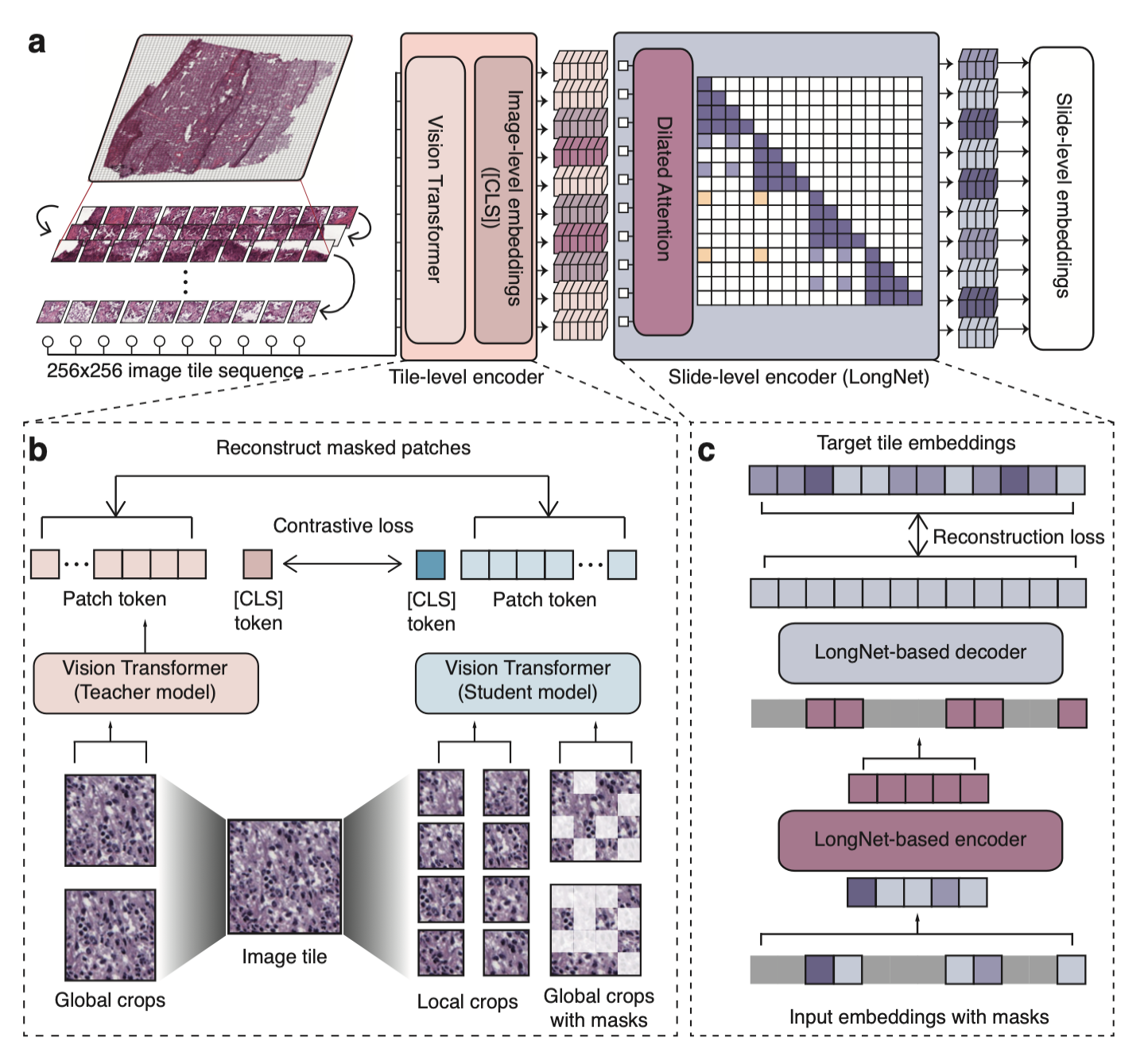Prov-GigaPath
A whole-slide foundation model for digital pathology from real-world data
[Code] [Model] [Paper] [BibTeX]
Hanwen Xu*, Naoto Usuyama*, Jaspreet Bagga, Sheng Zhang, Rajesh Rao, Tristan Naumann, Cliff Wong, Zelalem Gero, Javier González, Yu Gu, Yanbo Xu, Mu Wei, Wenhui Wang, Shuming Ma, Furu Wei, Jianwei Yang, Chunyuan Li, Jianfeng Gao, Jaylen Rosemon, Tucker Bower, Soohee Lee, Roshanthi Weerasinghe, Bill J. Wright, Ari Robicsek, Brian Piening, Carlo Bifulco, Sheng Wang, Hoifung Poon (*Equal Contribution)
Model Overview

Overview of Prov-GigaPath model architecture
Install
On an NVIDIA A100 Tensor Core GPU machine, with CUDA toolkit enabled.
- Download our repository and open the Prov-GigaPath
git clone https://github.com/prov-gigapath/prov-gigapath
cd prov-gigapath
- Install GigaPath and its dependencies
conda env create -f environment.yaml
conda activate gigapath
pip install -e .
Model Download
The Prov-GigaPath models can be accessed from HuggingFace Hub.
You need to agree to the terms to access the models. Once you have the necessary access, set your HuggingFace read-only token as an environment variable:
export HF_TOKEN=<huggingface read-only token>
If you don’t set the token, you might encounter the following error:
ValueError: We have no connection or you passed local_files_only, so force_download is not an accepted option.
Inference
The Prov-GigaPath model consists of a tile encoder, that extracts local patterns at patch level, and a slide encoder, that outputs representations at slide level. This model can be used in both tile-level and slide-level tasks. When doing inference at the slide level, we recommend following this pipeline: (1) Tile the whole slide into N image tiles, with the coordinates of each tile. (2) Get the embeddings for each tile using our tile encoder. (3) Pass the N image tile embeddings and their coordinates into the slide encoder, to get slide level representations.
Inference with the tile encoder
First, load GigaPath tile encoder:
import timm
from PIL import Image
from torchvision import transforms
import torch
tile_encoder = timm.create_model("hf_hub:prov-gigapath/prov-gigapath", pretrained=True)
transform = transforms.Compose(
[
transforms.Resize(256, interpolation=transforms.InterpolationMode.BICUBIC),
transforms.CenterCrop(224),
transforms.ToTensor(),
transforms.Normalize(mean=(0.485, 0.456, 0.406), std=(0.229, 0.224, 0.225)),
]
)
Running inference to extract tile level features:
img_path = "images/prov_normal_000_1.png"
sample_input = transform(Image.open(img_path).convert("RGB")).unsqueeze(0)
tile_encoder.eval()
with torch.no_grad():
output = tile_encoder(sample_input).squeeze()
Inference with the slide encoder
To inference with our slide encoder, we need both the tile embeddings and their coordinates as input. First, let's load the GigaPath slide encoder:
import gigapath
slide_encoder = gigapath.slide_encoder.create_model("hf_hub:prov-gigapath/prov-gigapath", "gigapath_slide_enc12l768d", 1536)
Run the inference to get the slide level embeddings:
slide_encoder.eval()
with torch.no_grad():
output = slide_encoder(tile_embed, coordinates).squeeze()
Fine-tuning
Tile-Level Linear Probing Example Using PCam Dataset
For your convenience, we provide the pre-extracted embeddings for the PCam dataset. You can download them from the link below. Note that the file size is 2GB.
wget -nc https://hanoverprod.z21.web.core.windows.net/gigapath/GigaPath_PCam_embeddings.zip -P data/
There is no need to unzip this file.
To run the fine-tuning experiment, execute the following script:
bash scripts/run_pcam.sh data/GigaPath_PCam_embeddings.zip
Slide-Level Fine-Tuning Example Using PANDA Dataset
For your convenience, we provide the pre-extracted embeddings for the PANDA dataset. You can download them from the link below. Note that the file size is 32GB. Please unzip this file.
wget -nc https://hanoverprod.z21.web.core.windows.net/gigapath/GigaPath_PANDA_embeddings.zip -P data/
unzip -n data/GigaPath_PANDA_embeddings.zip -d data/
To run the fine-tuning experiment, execute the following script:
bash scripts/run_panda.sh data/GigaPath_PANDA_embeddings/h5_files
Sample Data Download
A sample de-identified subset of the Prov-Path data can be accessed from these links [1, 2].
Model Uses
Intended Use
The data, code, and model checkpoints are intended to be used solely for (I) future research on pathology foundation models and (II) reproducibility of the experimental results reported in the reference paper. The data, code, and model checkpoints are not intended to be used in clinical care or for any clinical decision-making purposes.
Primary Intended Use
The primary intended use is to support AI researchers reproducing and building on top of this work. GigaPath should be helpful for exploring pre-training, and encoding of digital pathology slides data.
Out-of-Scope Use
Any deployed use case of the model --- commercial or otherwise --- is out of scope. Although we evaluated the models using a broad set of publicly-available research benchmarks, the models and evaluations are intended for research use only and not intended for deployed use cases.
Usage and License Notices
The model is not intended or made available for clinical use as a medical device, clinical support, diagnostic tool, or other technology intended to be used in the diagnosis, cure, mitigation, treatment, or prevention of disease or other conditions. The model is not designed or intended to be a substitute for professional medical advice, diagnosis, treatment, or judgment and should not be used as such. All users are responsible for reviewing the output of the developed model to determine whether the model meets the user’s needs and for validating and evaluating the model before any clinical use.
Acknowledgements
We would like to express our gratitude to the authors and developers of the exceptional repositories that this project is built upon: DINOv2, MAE, Timm, and TorchScale. Their contributions have been invaluable to our work.
Citation
If you find Prov-GigaPath useful for your your research and applications, please cite using this BibTeX:
@article{xu2024gigapath,
title={A whole-slide foundation model for digital pathology from real-world data},
author={Xu, Hanwen and Usuyama, Naoto and Bagga, Jaspreet and Zhang, Sheng and Rao, Rajesh and Naumann, Tristan and Wong, Cliff and Gero, Zelalem and González, Javier and Gu, Yu and Xu, Yanbo and Wei, Mu and Wang, Wenhui and Ma, Shuming and Wei, Furu and Yang, Jianwei and Li, Chunyuan and Gao, Jianfeng and Rosemon, Jaylen and Bower, Tucker and Lee, Soohee and Weerasinghe, Roshanthi and Wright, Bill J. and Robicsek, Ari and Piening, Brian and Bifulco, Carlo and Wang, Sheng and Poon, Hoifung},
journal={Nature},
year={2024},
publisher={Nature Publishing Group UK London}
}
- Downloads last month
- 105,776
